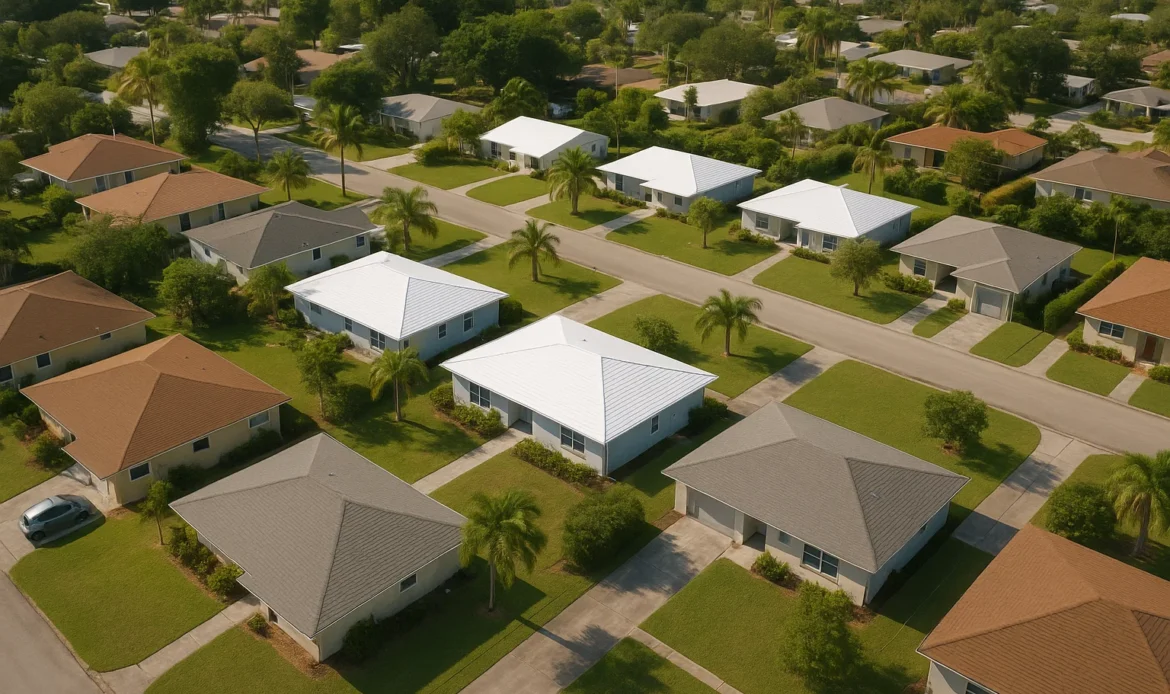Delray Beach—like many coastal South Florida cities—faces rising urban heat island (UHI) stress. Dark roofs and pavements routinely trap sunlight, elevating ambient neighborhood temperatures. But smart roofing choices, such as reflective (“cool”) roofs and green roof systems, can mitigate these effects, ease energy loads, and improve comfort. Local expert Pixel Homes offers Delray Beach homeowners fully tailored solutions for building resilience and environmental comfort.
Understanding the Heat Island Effect
Urban heat islands occur when built environments absorb and retain heat, often making cities up to 5 °C warmer than surrounding areas. Nearly 40% of this excess heat is tied to dark roofs and paved surfaces, which absorb most solar radiation.
Reflective or “cool” roofs, by contrast, boast high solar reflectance (albedo) and thermal emittance—meaning they shed less heat into buildings and neighborhoods.
How Roofing Choices Can Cool Delray Beach
1. Cool Roofs (Reflective or Light-Colored)
Cool roofs—especially white vinyl membranes like PVC or TPO—can stay 50–60°F cooler than dark roofs under intense sun.
On hot days, these roofs reduce indoor temperatures by 1.2–3.3 °C (~2.2–5.9°F) and help cool surrounding air, reducing UHI impacts.
Modeling studies show that across urban areas, cool roofs lowered outdoor temperatures by ~1.2 °C—outperforming green roofs and solar panels in effectiveness.
2. Green Roofs
A vegetated (“green”) roof can reduce rooftop temperatures by up to 30 °C, lower ambient air temperatures, and decrease building cooling needs by 25–80%.
While less common in South Florida’s residential rooftops, green roofs are an effective complement to cool surfaces in dense or multifamily settings.
3. Radiant Barriers and Advanced Underlayments
Radiant barriers installed in attics block up to 82 W/m² of heat flux, significantly reducing heat transmission below the roof deck.
These systems are especially effective when paired with a cool exterior roof surface.
Why Delray Beach Should Embrace Cool Roofing
- Persistent Heat Waves: Cooler roofs reduce both interior heat gain and street-level temperatures.
- Energy Savings: Homeowners report 10–15% reductions in cooling electricity use on hot days.
- Increased Comfort & Lower Emissions: Cooler roofs ease AC load, reduce emissions, and improve comfort indoors and outdoors.
- Community Impacts: Studies suggest cool roofs in densely built areas can reduce local mortality during heatwaves, as seen in London modeling.
Pixel Homes: Cool-Roof Experts in Delray Beach
Pixel Homes offers reflective, durable roofing systems tailored for Delray Beach’s climate:
- Cool Roof Installations: Options include Energy Star®-rated reflective shingles and white vinyl systems offering high solar reflectance.
- Radiant Barrier Upgrades: Attic insulation and radiant barrier systems help keep interior spaces cooler year-round.
- Green Roof Options: In select projects, lightweight green roof installations for patios or flat structures further reduce heat absorption.
- Maintenance & Cleaning: Pixel Homes advises on surface cleaning to sustain albedo performance over time.
- Climate-Conscious Design: Combining impact-rated, reflective, and well-ventilated roofing ensures compliance with coastal building standards.
Benefits to Delray Beach Residents
- Lower Ambient Temperatures: Reflective roofs contribute to neighborhood cooling, offering system-wide benefits.
- Reduced Utility Bills: With indoor temps reduced, homes use less AC, saving on power costs.
- Extended Roof Lifespan: Cooler surfaces slow material degradation from UV and heat cycles.
- Environmental Impact: Mitigating UHI helps lower peak energy demand, reducing pollution and grid strain.
Things to Consider Before Upgrading
- Choose Materials with High Solar Reflectance Index (SRI): Products rated for high SRI ensure maximum reflectivity and emissivity.
- Assess Roof Type and Slope: Flat or low-slope roofs may benefit most from cool vinyl membranes, while pitched roofs can utilize reflective shingles.
- Maintenance Plan: Regular rinsing or soft wash prevents dirt buildup and preserves reflective performance.
- Complement with Insulation and Ventilation: Proper attic ventilation and radiant barriers maximize whole-home cooling gains.
- Combine with Urban Greening: Planting shade trees and using light-colored pavement further improves block-level cooling.
Expert Insights & Evidence
A UCL study projected that city-wide roof whitening in London could reduce heat-related deaths by nearly 33%, with ambient air temperature reductions of around 0.8 °C.
The U.S. Department of Energy and EPA highlight that cool roofs help reduce outdoor air temperatures, cut AC demand, and mitigate urban smog formation during heat waves.
Oak Ridge National Laboratory research showed reflective roofs cut peak heat flux into the home by up to 82 W/m², keeping interiors notably cooler.
Conclusion
Yes—roofing choices in Delray Beach can significantly reduce local heat waves and improve indoor comfort and performance. From cool roofs to radiant barriers and even green roofing in multi-unit developments, nodes of reflection and insulation can reduce ambient temperatures, lower energy costs, and extend roof life.
Pixel Homes delivers climate-smart roofing solutions—from high-reflectance materials to installation systems designed for South Florida’s heat and humidity. By choosing cooler roofing, Delray Beach residents can contribute to a cooler, more sustainable neighborhood while reaping direct benefits at home.
Q1: How do cool roofs reduce the heat island effect in Delray Beach?
A1: Cool roofs reflect more sunlight and emit absorbed heat, lowering rooftop and ambient temperatures, which reduces urban heat stress and cooling costs.
Q2: What is the difference between cool roofs and green roofs?
A2: Cool roofs reflect sunlight with light-colored or reflective surfaces, while green roofs use vegetation to lower heat and insulate buildings. Both reduce UHI impacts.
Q3: Can reflective roofs help lower energy bills for Delray Beach homeowners?
A3: Yes. Reflective roofs and radiant barriers can reduce indoor cooling demand by 10–15%, lowering electricity bills and easing strain on AC systems.
Q4: Are green roofs practical for South Florida homes?
A4: While less common for single-family homes, green roofs are effective on flat or multi-unit buildings, helping reduce heat and improve comfort.
Q5: What factors should be considered before installing a cool roof in Delray Beach?
A5: Homeowners should check SRI ratings, roof type, slope, maintenance needs, and consider pairing with insulation and ventilation for maximum efficiency.
